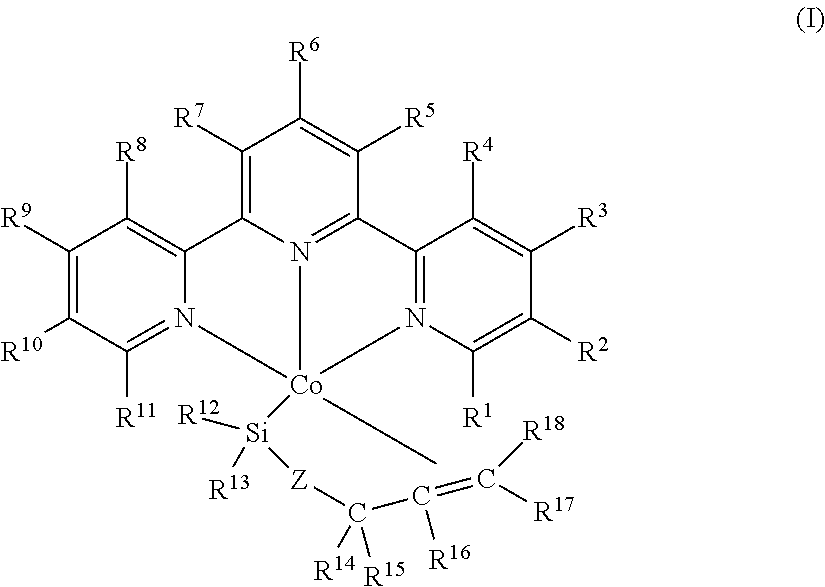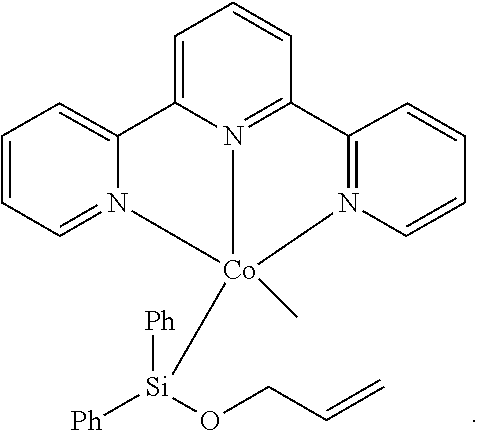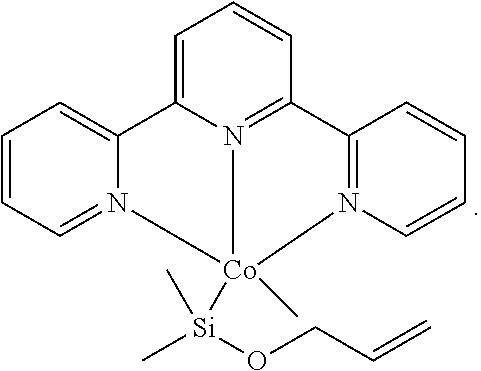Cobalt catalysts and their use for hydrosilylation and dehydrogenative silylation
a catalyst and cobalt technology, applied in the direction of organic compounds/hydrides/coordination complex catalysts, physical/chemical process catalysts, organic chemistry, etc., can solve the problems of metal catalyzed hydrosilylation only working well, limited commercially viable methods, and unsaturation of the original substra
- Summary
- Abstract
- Description
- Claims
- Application Information
AI Technical Summary
Benefits of technology
Problems solved by technology
Method used
Image
Examples
example 1
Synthesis of allyloxydiphenylsilane
[0089]
[0090]The synthesis of allyloxydiphenylsilane follows a modified literature procedure as described by Bergens, S. H.; Noheda, P.; Whelan, J.; Bosnich, B. J. Am. Chem. Soc. 1992, 114, 2121-2128 and was carried out in air. A solution of allyl alcohol (2.9 g, 50 mmol) and triethylamine (5.1 g, 50 mmol) in Et2O (250 mL) was cooled in an ice bath. With rapid stirring, chlorodiphenylsilane (11 g, 50 mmol) was added dropwise to the solution. Large quantities of a fluffy white precipitate (Et3NHCl) were observed immediately. The mixture was warmed to room temperature and stirred for 1 h. The resulting solution was filtered through Celite and washed with Et2O. The filtrate was concentrated and yielded a colorless oil, which upon distillation (84-85° C., 65 mmTorr) afforded the desired product as a colorless oil in 80% yield. 1H NMR (400 MHz, benzene-d6) δ 7.74-7.62 (m, 4H), 7.27-7.06 (m, 6H), 5.81 (ddt, J=17.1, 10.6, 4.6 Hz, 1H), 5.69 (s, 1H), 5.31 (d...
example 2
Synthesis of allyloxydimethylsilane
[0091]
[0092]Allyloxydimethylsilane was prepared in a manner similar to allyloxydiphenylsilane. A solution of allyl alcohol (2.9 g, 50 mmol) and triethylamine (5.1 g, 50 mmol) in Et2O (250 mL) was cooled in an ice bath. While rapid stirring, the solution was added with chlorodimethylsilane (4.7 g, 50 mmol) dropwise. Large quantities of a fluffy white precipitate (Et3NHCl) were observed immediately. The mixture was warmed to room temperature and stirred for 1 hour. The resulting solution was filtered through Celite and washed with Et2O. The filtrate was concentrated to yield a colorless oil, which following factional distillation (79-83° C.), afforded the product as a colorless oil in 50% yield. 1H NMR (400 MHz, chloroform-d) δ 5.93 (ddt, J=17.2, 10.1, 5.0 Hz, 1H), 5.26 (dq, J=17.2, 1.8 Hz, 1H), 5.12 (dq, J=10.4, 1.6 Hz, 1H), 4.68-4.55 (m, 1H), 4.18 (dt, J=5.0, 1.7 Hz, 2H), 0.23 (s, 3H), 0.23 (s, 3H)
example 3
Synthesis of (terpy)Co(CH2TMS)
[0093]
[0094]The solution of py2Co(CH2TMS)2 (390 mg, 1 mmol) in pentane (20 mL) were prepared following literature procedures and cooled to −35° C. Zhu, D.; Janssen, F. F. B. J.; Budzelaar, P. H. M. Organometallics 2010, 29, 1897. The terpyridine ligand (233 mg, 1 equiv) was dissolved in pentane and added into the solution containing the cobalt compound. An immediate color change from green into purple was observed. The solution was stirred at room temperature for 0.5 hours, followed by removal of the volatile components in vacuo. The residue was dissolved in pentane and filtered through Celite to yield (terpy)Co(CH2TMS)2. The solution of (terpy)Co(CH2TMS)2 in Et2O was stirred for 4 hours to generate the mono-neosilyl complex and following recrystallization from toluene / pentane at −35° C. yielded a purple solid. 1H NMR (400 MHz, benzene-d6) δ 12.23 (d, J=6.2 Hz, 3H), 8.64 (t, J=7.6 Hz, 2H), 8.01 (t, J=6.8 Hz, 2H), 7.55 (d, J=8.2 Hz, 2H), 7.02 (d, J=7.5 H...
PUM
| Property | Measurement | Unit |
|---|---|---|
| temperature | aaaaa | aaaaa |
| temperature | aaaaa | aaaaa |
| molar mass | aaaaa | aaaaa |
Abstract
Description
Claims
Application Information
 Login to View More
Login to View More - R&D
- Intellectual Property
- Life Sciences
- Materials
- Tech Scout
- Unparalleled Data Quality
- Higher Quality Content
- 60% Fewer Hallucinations
Browse by: Latest US Patents, China's latest patents, Technical Efficacy Thesaurus, Application Domain, Technology Topic, Popular Technical Reports.
© 2025 PatSnap. All rights reserved.Legal|Privacy policy|Modern Slavery Act Transparency Statement|Sitemap|About US| Contact US: help@patsnap.com



